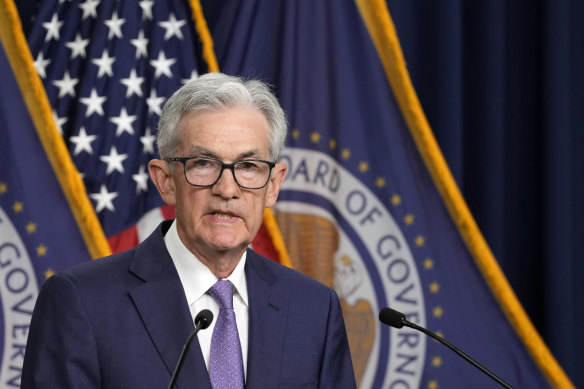- Updated
- Business
- Markets
- World markets
Miners push ASX to record close after Fed unleashes jumbo rate cut
By Brittany Busch
Welcome to your five-minute recap of the trading day.
The numbers
The Australian sharemarket soared to new heights on Thursday and finished at a record, despite a midday wobble that saw it lose its morning-session gains.
The S&P/ASX 200 breached 8200 points in afternoon trading before retreating slightly to close up 49.8 points, or 0.6 per cent, at 8191.9. Six of the 11 industry sectors advanced, with utilities and mining posting the biggest gains, while industrials and healthcare stocks led declines.
The record close came after the US Federal Reserve delivered a whopper interest rate cut in an attempt to bolster the world’s largest economy, and local jobs data showed the Australian unemployment rate held steady.

Fed chairman Jerome Powell. Markets are hopeful the central bank can engineer a perfect landing for the US economy.Credit: AP
The lifters
The world’s most important central bank cut its key interest rate by half a percentage point, jolting financial and commodity markets while putting pressure on Australia’s Reserve Bank to bring forward its own plans for rate relief.
With the Fed cut boosting optimism for looser monetary conditions globally, Australia’s mining heavyweights pushed the sector to the top of the local bourse, with BHP climbing 2.6 per cent, Rio Tinto jumping 3.5 per cent and Fortescue up 1.2 per cent.
The biggest large-cap gainers included James Hardie Industries (up 5.4 per cent), Telix Pharmaceuticals (up 5.1 per cent) and Lynas Rare Earths (up 3.7 per cent).
The financial sector also advanced, with Commonwealth Bank (up 0.5 per cent), Westpac (up 0.6 per cent), ANZ (up 1.1 per cent) and NAB (up 0.2 per cent) all gaining.
The laggards
On the flipside, industrial stocks suffered the heaviest losses.
Large-cap shrinkage dragged the sector, with laboratory testing company ALS plummeting 8.6 per cent after it issued a profit warning, toll road operator Atlas Arteria shedding 3.6 per cent after announcing its dividend distribution, and financial administrator Computershare dropping 3.5 per cent.
The lowdown
Betashares chief economist David Bassanese said US markets may have priced in the Fed rate cut more accurately than the local bourse.
“[It’s] pretty good market performance, given Wall Street was a little bit nonplussed about what the Fed did overnight,” Bassanese said.
“Miners were a big driver today, iron ore went up. It’s maybe the idea that lower US interest rates, lower US dollar is positive for commodities, and therefore positive for our market, but I think more broadly our market seems to have taken a more optimistic take on the Fed overnight,” he said, with Wall Street having largely priced in a 50 basis point cut already over the past few days.

Wall Street retreated into the close.Credit: AP
Local jobs data showing the Australian unemployment rate remained steady at 4.2 per cent, with 47,500 jobs added to the economy in August, also exceeded expectations, Bassanese said.
“Overall, the numbers suggest, despite the weakness of consumer spending, there is certainly life going on in the economy and certainly no green light for the RBA to consider rate cuts any time soon.”
Overnight in New York, Wall Street wavered near its records after the Fed kicked off its efforts to prevent a recession, but retreated during Fed chair Jerome Powell’s press conference in which he poured water on hopes it was the beginning of a series of aggressive rate cuts.
The S&P 500 initially rose but closed 0.3 per cent lower after his comments. The Dow Jones shed 103 points, or 0.3 per cent. The Nasdaq composite lost 0.3 per cent.
The Fed released forecasts that said its median official expects to cut the federal funds rate by another half of a percentage point through the end of the year. That could mean a traditional-sized cut of 0.25 percentage points at each of its two remaining meetings scheduled for 2024. After that, the median Fed official is projecting another full percentage point of cuts during 2025.
Some critics say the Federal Reserve may have already kept interest rates too high for too long, doing damage to the economy.
“When the Fed is behind the curve, it sometimes takes a big move to catch up to where they should have been all along,” said Brian Jacobsen, chief economist at Annex Wealth Management.
Tweet of the day
Quote of the day
”The love [European] customers have for Decathlon, I would really compare to the love Australians have for Bunnings … The connection is really strong,” Decathlon Australia chief executive Romain Gravigny said as the French sporting goods retailer overhauls its local strategy.
You may have missed
Australia’s bosses are calling an end to the flexible workplace, with a KPMG chief executive survey showing that 82 per cent of respondents expect white-collar workers to be back in the office five days a week in three years.
This was up from just 66 per cent in last year’s survey, but the same proportion of CEO respondents – 78 per cent – said they would reward office-based employees with pay rises and promotions.
with AP
The Market Recap newsletter is a wrap of the day’s trading. Get it each weekday afternoon.